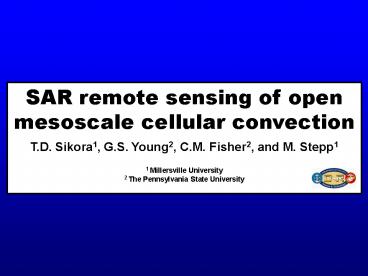SAR remote sensing of open mesoscale cellular convection - PowerPoint PPT Presentation
1 / 23
Title:
SAR remote sensing of open mesoscale cellular convection
Description:
... Data SDWS from JHUAPL comprehensive on-line archive http://fermi.jhuapl.edu/sar/stormwatch/web_wind/ Mostly R1 ScanSAR Wide B Some other R1 products and ... – PowerPoint PPT presentation
Number of Views:77
Avg rating:3.0/5.0
Title: SAR remote sensing of open mesoscale cellular convection
1
SAR remote sensing of open mesoscale cellular
convection T.D. Sikora1, G.S. Young2, C.M.
Fisher2, and M. Stepp1 1 Millersville
University 2 The Pennsylvania State University
2
- Introduction
- Young et al. (2007) investigated cold-air
outbreak open mesoscale cellular convection via a
case study for the Gulf of Alaska - Employed nearly coincident MODIS and SAR-derived
wind speed (SDWS)
3
- Previous findings
- Young et al. (2007)
- Demonstrated spatial and temporal correspondence
between MODIS and SDWS signatures of open cell
convection
4
SDWS image from 0301 UTC on 8 November 2006.
Pixel size is 600 m by 600 m. Pale blue arrows
indicate the NOGAPS wind vectors. The squall
appears as an area of stronger wind (1), with a
sharp gradient along its leading edge. The
trailing lull appears as an area of weaker wind
upwind of the squall (2), with the cells sides
and upwind edge also marked by a sharp gradient
of wind speed (3).
5
MODIS true color image from the Aqua satellite at
2310 UTC on 7 November 2006. The pixel size is
500 m by 500 m. The image is 100 km by 100 km.
The arc clouds are found along the downwind edge
(1) of the nearly cloud-free center (2) while
ring clouds are found along the cells sides and
rear (3).
6
- Previous findings
- Young et al. (2007)
- Arc clouds reached to 500 hPa
- Deeper than for previously reported results of
open cell convection at middle- to high-latitude
(see Atkinson and Zhang 1996 and Brümmer
1997,1999) - Arc clouds were glaciated
7
- Motivation
- Young et al. (2007) suggested the need for a
comprehensive remote sensing-based study of
middle- to-high latitude open cell convection
8
- Objective
- The present research satisfies that need via
eight-year (1999-2006) Northeast Pacific Ocean
climatology of - Frequency of open cell convection
- Thermodynamic and kinematic environment of its
formation
9
- Data
- SDWS from JHUAPL comprehensive on-line archive
- http//fermi.jhuapl.edu/sar/stormwatch/web_wind/
- Mostly R1 ScanSAR Wide B
- Some other R1 products and satellite SARs
10
- Data
- Reanalyses from NCEP/NCAR Reanalysis Project
- http//www.cdc.noaa.gov/cdc/reanalysis/reanalysis.
shtml - Surface sensible and latent heat flux, sea
surface temperature, and air temperature and wind
vector at the near-surface and at 925 hPa, 850
hPa, 700 hPa, and 500 hPa
11
- Procedures
- From 1999 to 2006, 616 events of open cell
convection were observed via SDWS
12
- Procedures
- Not all events are independent
13
- Procedures
- For each event center location, nearest
reanalysis data was retrieved
14
Frequency results
15
Thermodynamic and kinematic results
16
- Thermodynamic results
- Fluxes
- Values in keeping with previously reported
results - Supportive of surface based convection
- Thermodynamic profiles
- Values for cloud layer and below in keeping with
previously reported results - Upper-layer value implies rather deep (500 hPa)
open cell convection was possible - Similar to Young et al. (2007)
17
- Kinematic results
- Vertical wind shear
- Lower-layer value in keeping with previously
reported results - Vertical distribution
- Large lower-layer value and small mid-layer value
- Reminiscent of that associated with
radar-detected arcs of tropical deep moist
convection (see LeMone et al. 1998 and Johnson
et al. 2005)
18
- Discussion
- Young et al. (2007)
- Suggested similarity between middle- to
high-latitude open cell convection and tropical
deep moist convection - Related to precipitation-driven cold pools and
resulting arcs of deeper convection
19
(No Transcript)
20
- Discussion
- The present research supports Young et al.s
suspicions - However, we have no precipitation data
21
- Future work
- Precipitation verification
- Employ NWS weather radar from Alaska Region
22
(No Transcript)
23
- Reference
- Sikora, T. D., G. S. Young, C. M. Fisher, and M.
D. Stepp, 2011 A synthetic aperture radar-based
climatology of open cell convection over the
northeast Pacific Ocean. J. Appl. Meteor.
Climatol., 50, 594-603.































